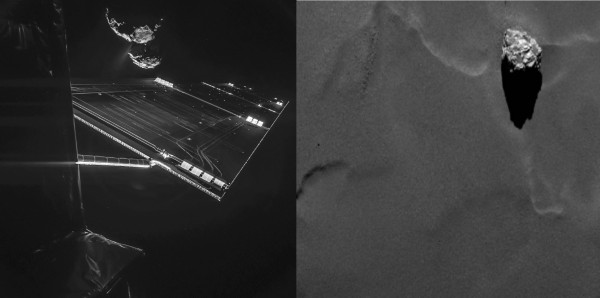Rosetta Spacecraft Snaps Selfie while Orbiting Comet 67P
| Ana Verayo | | Oct 14, 2014 11:19 PM EDT |
(Photo : ESA/Rosetta/Philae/CIVA ) Rosetta takes a selfie at a distance of about 16 km from the surface of 67P/C-G.
As the European Space Agency's Rosetta spacecraft approaches Comet 67P/Churyumov-Gerasimenko, it's documenting its mission by capturing the most remarkable photographs.
These include a selfie of itself along with detailed close-ups of the comet showing what appears to be a pyramid rock on the comet's surface.
Like Us on Facebook
Using the CIVA (Comet Infrared and Visible Analyzer) camera on its Philae lander, Rosetta caught an image that demonstrates the comet's dynamic activity such as intense jets of gas and comet dust caused by a process called sublimation.
Sublimation occurs when a comet's surface temperatures increases rapidly as it approaches the sun. Since Comet 67P has an icy nucleus, the heated ice doesn't turn into liquid water in space but into jet streams of gas.
Another remarkable photo of thecomet includes an odd shaped rock formation that resembles a pyramid. The ESA Rosetta team named this boulder "Cheops" after the largest pyramid in Giza, Egypt.
Rosetta took photos of Cheops last August but the new images show more detailed features of the pyramid boulder.
The pyramid measures about 147 feet across the surface and has very craggy and irregular features, said OSIRIS Principal Investigator Holger Sierks of the Max Planck Institute for Solar System Research.
Sierks adds there are small patches found on the boulder's surface that have similar brightness and texture as the comet's underground.
Scientists hope to unravel the Cheops mystery as soon as the Philae lander attaches itself to the comet on November 12. Philae will study Comet 67P's terrain and composition and hopefully unlock the secrets of the early birth of the solar system.
Rosetta traveled in deep space for 10 years to reach comet 67P/Churyumov-Gerasimenko. It rendezvoused with the comet last August, becoming the first spacecraft ever to orbit a comet.
TagsRosetta Spacecraft Snaps Mission Selfie with Comet 67P and Bizarre Pyramid Shaped Rock, ESA, rosetta, comet 67P, rosetta comet 67P selfie pyramid rock boulder photo
©2015 Chinatopix All rights reserved. Do not reproduce without permission
EDITOR'S PICKS
-

Did the Trump administration just announce plans for a trade war with ‘hostile’ China and Russia?
-

US Senate passes Taiwan travel bill slammed by China
-

As Yan Sihong’s family grieves, here are other Chinese students who went missing abroad. Some have never been found
-

Beijing blasts Western critics who ‘smear China’ with the term sharp power
-

China Envoy Seeks to Defuse Tensions With U.S. as a Trade War Brews
-

Singapore's Deputy PM Provides Bitcoin Vote of Confidence Amid China's Blanket Bans
-

China warns investors over risks in overseas virtual currency trading
-

Chinese government most trustworthy: survey
-

Kashima Antlers On Course For Back-To-Back Titles
MOST POPULAR
LATEST NEWS
Zhou Yongkang: China's Former Security Chief Sentenced to Life in Prison

China's former Chief of the Ministry of Public Security, Zhou Yongkang, has been given a life sentence after he was found guilty of abusing his office, bribery and deliberately ... Full Article
TRENDING STORY

China Pork Prices Expected to Stabilize As The Supplies Recover

Elephone P9000 Smartphone is now on Sale on Amazon India

There's a Big Chance Cliffhangers Won't Still Be Resolved When Grey's Anatomy Season 13 Returns

Supreme Court Ruled on Samsung vs Apple Dispute for Patent Infringement

Microsoft Surface Pro 5 Rumors and Release Date: What is the Latest?










